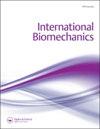基于图像的受试者特定动力学模型预测侧身坠落的冲击力
Q2 Medicine
引用次数: 22
摘要
侧落时施加在大转子上的冲击力是决定髋部是否发生骨折的关键因素。然而,冲击力与受试者有关,因为它与受试者的人体测量参数和跌倒时的运动学变量有关。目前可用的动力学模型无法准确预测。我们开发并验证了一种构建特定对象动力学模型的方法,以更准确地预测冲击力。模型所需的人体测量参数来自受试者全身DXA(双能x射线吸收测量)图像。然后通过使用年轻志愿者的保护性跌落测试验证了受试者特定的动力学模型。使用从当地骨质疏松症临床中心获得的90张临床DXA图像,研究了人体测量参数对冲击力的影响。与现有的经验函数预测的结果相比,学科特定动力学模型预测的撞击力与实验数据吻合得更好。参数化研究结果表明,虽然体重和身高是影响冲击力的主要参数,但碰撞前髋部垂直速度等其他参数也有相当大的影响。这一发现表明,现有的仅考虑体重和身高的经验函数可能无法准确预测冲击力。由于骨质疏松症临床中心可以轻松获得全身DXA图像,因此该方法可能在临床中具有潜在的应用价值,以改进对跌倒性髋部骨折风险的评估。本文章由计算机程序翻译,如有差异,请以英文原文为准。
Prediction of impact force in sideways fall by image-based subject-specific dynamics model
The impact force applied to the greater trochanter during sideways fall is a critical factor for determining whether or not a hip fracture would occur. However, the impact force is subject-dependent as it is related to the subject’s anthropometric parameters and the kinematic variables in fall. It cannot be accurately predicted by the currently available dynamics models. We developed and validated a method for constructing subject-specific dynamics models to more accurately predict the impact force. The anthropometric parameters required in the model were obtained from the subject’s whole body DXA (dual energy X-ray absorptiometry) image. The subject-specific dynamics models were then validated by protected fall tests using young volunteers. The effects of anthropometric parameters on the impact force were investigated using 90 clinical DXA images obtained from a local osteoporosis clinic center. The impact forces predicted by subject-specific dynamics models had much better agreement with the experimental data, compared with those predicted by the existing empirical functions. The parametric study results indicated that although body weight and height are the dominant parameters affecting the impact force, other parameters such as the hip vertical velocity before impact also have considerable effects. This finding suggests that the existing empirical functions that only consider body weight and height may not be able to accurately predict the impact force. As whole body DXA images are readily available in osteoporosis clinic centers, the proposed method may have potential applications in the clinic to improve the assessment of fall-induced hip fracture risk.
求助全文
通过发布文献求助,成功后即可免费获取论文全文。
去求助
来源期刊

International Biomechanics
Medicine-Rehabilitation
CiteScore
1.90
自引率
0.00%
发文量
2
审稿时长
17 weeks
期刊介绍:
International Biomechanics is a fully Open Access biomechanics journal that aims to foster innovation, debate and collaboration across the full spectrum of biomechanics. We publish original articles, reviews, and short communications in all areas of biomechanics and welcome papers that explore: Bio-fluid mechanics, Continuum Biomechanics, Biotribology, Cellular Biomechanics, Mechanobiology, Mechano-transduction, Tissue Mechanics, Comparative Biomechanics and Functional Anatomy, Allometry, Animal locomotion in biomechanics, Gait analysis in biomechanics, Musculoskeletal and Orthopaedic Biomechanics, Cardiovascular Biomechanics, Plant Biomechanics, Injury Biomechanics, Impact Biomechanics, Sport and Exercise Biomechanics, Kinesiology, Rehabilitation in biomechanics, Quantitative Ergonomics, Human Factors engineering, Occupational Biomechanics, Developmental Biomechanics.
 求助内容:
求助内容: 应助结果提醒方式:
应助结果提醒方式:


